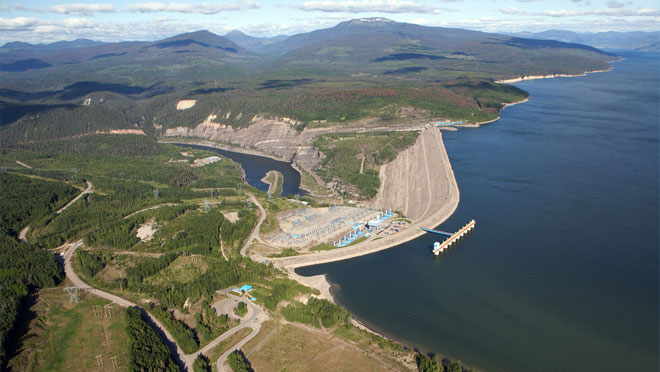SolarPV can now deliver energy as cheaply as 3 cents per kilowatt-hour in some parts
of the globe. At British Columbia's latitude & climate (which
give us longer periods of darkness), we can expect a higher but still
competitive cost for photovoltaic power.
With current economics, technology and climate imperatives, a rapid transition to
sustainable energy is entirely possible. Indeed it will be necessary,
if we are to remain competitive in global markets. In other words, if
we wish to compete with equatorial nations of the world where 3 cents
an hour solar electricity is easy, we had better get our act together
in British Columbia pretty fast.
The only thing standing in the way of the rapid acceptance of sustainable energy in
the world is the intermittency of solar and wind (& tidal &
wave) energy. But in British Colombia this should be no barrier at
all.
Many cling to the belief that improved battery storage will solve the intermittency
problem, but that belief is nullified by the realities of chemistry:
batteries require typically ~50 times the mass of fossil fuels to
deliver the same energy. They also require frequent replacement.
Improved batteries will be important for some applications, such as
electric vehicles, but otherwise they will provide only a minor
contribution to our energy challenges. Only stored hydro has the
magnitude and durability to address the intermittency problem on a
provincial and continental scale.
We need to be able to provide hydroelectricity on demand throughout diurnal and annual
cycles. We must be able to reliably generate electricity even when
the sun has set, and when the wind is calm. British Columbia has a
unique advantage in this regard, as we have abundant precipitation
filling large bodies of water at elevation. Many of our natural lakes
and engineered reservoirs can produce hydroelectricity as needed on
demand without severe downstream consequences. The Columbia &
Peace River systems comprise reservoir-to-reservoir flow, which is
particularly powerful for this purpose. So can the lakes on Vancouver
Island and the mainland coast, which can discharge their flow
directly into tidewater.
In order to realize a rapid transition to sustainable energy, a few steps will be essential:
Simplify all
regulatory matters that presently pose a barrier to individual and
communal solar photovoltaic electricity production. It should be
cheap and easy to link into the provincial power grid. Once the
regulatory barriers are lowered, market forces will rapidly promote
the installation of solarPV panels in all regions of British Columbia.
We need to
change the mindset of the BC Hydro Board of Directors. That Board
has historically viewed energy from the perspective of the fossil
fuel (especially natural gas) industries. It is essential to
recognize the depth of the current bias, because BC Hydro has
repeatedly and consistently overlooked British Columbia's amazing
potential for hydro-on-demand. This topic has a long history; I'd be
happy to discuss it further with anyone who is interested.
Step up the
expansion of peak generating capacity on the Columbia and Peace
river systems, and at all other BC Hydro generating stations.
Preserve and
reclaim provincial water rights on all watersheds that are well
positioned to deliver hydro-on demand. In particular, we should
reclaim the billions of dollars (in 2016 values) of public investment that was made for the
Kemano Completion Project on the Nechako Reservoir. It is notable
that the key element to solve the intermittency problem has already
been built and paid for, out of the public purse. Reclaiming this
investment shall require a strong political will.
Sincerely,
Chris Aikman
@chrisaikman2
Additional reading:
